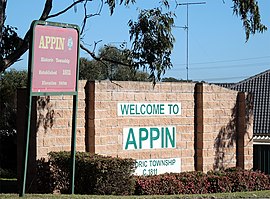Appin, New South Wales
| Appin New South Wales | |||||||||||||||
|---|---|---|---|---|---|---|---|---|---|---|---|---|---|---|---|
 Northern entry to Appin | |||||||||||||||
| Coordinates | 34°12′S 150°47′E / 34.200°S 150.783°E | ||||||||||||||
| Population | 2,633 (2016 census)[1] | ||||||||||||||
| Postcode(s) | 2560 | ||||||||||||||
| Elevation | 150 m (492 ft) | ||||||||||||||
| Location |
| ||||||||||||||
| LGA(s) | Wollondilly Shire | ||||||||||||||
| Region | Macarthur | ||||||||||||||
| State electorate(s) | Wollondilly | ||||||||||||||
| Federal division(s) | Macarthur | ||||||||||||||
| |||||||||||||||

Appin is a town in New South Wales, Australia in Wollondilly Shire. It is situated about 16 kilometres south of Campbelltown and 35 kilometres north west of Wollongong. In 2006, there were 1,423 people living in Appin. The fifth village settled in Australia, it is now on the fringe of the Sydney urban area.[2]
The town was named by Governor Lachlan Macquarie in 1811 after a small village on the coast of Scotland where his wife was born. [2] One of the first settlers was John Hume, whose son Hamilton Hume became a famous Australian explorer. Hamilton Hume explored the local area and was given a grant of 300 acres of land at Appin as a reward.[2] When he made his famous journey to Victoria with William Hovell in 1824, they started the journey from Appin.[2]
Appin is the birthplace of John Fuller (1830-1865), the Australian bushranger also known as Dan Morgan.[3]
Cataract Gorge is about 10 km south east of Appin. It is now has a dam built in 1906 which is the oldest dam in the Sydney water supply system.[2] On 17 April 1816, the British army killed many Aboriginal men, women and children, of the Dharawal Nation at the gorge.[2][4] They had been fighting the European settlers who were moving into the area.
The Roman Catholic church at Appin, St. Bede's, was built from 1837-1843.[2] The design was by Father John Therry (1790-1864), who became Australia's first Catholic priest in 1820.[5] St. Bede's is the oldest Catholic church still in continuous use.[6] It was named after St. Bede, the founder of the Benedictines.[source?]
References[change | change source]
- ↑ Australian Bureau of Statistics (27 June 2017). "Appin (State Suburb)". 2016 Census QuickStats. Retrieved 13 July 2017.
- ↑ 2.0 2.1 2.2 2.3 2.4 2.5 2.6 Appin - Sydney Morning Herald
- ↑ "Morgan, Daniel (Dan) (c. 1830 - 1865)". adbonline.anu.edu.au. Retrieved 1 January 2011.
- ↑ "K-6 Educational Resources :: Incidents between Aboriginal people in NSW and the British colonisers 1810–1822". k6.boardofstudies.nsw.edu.au. Archived from the original on 16 February 2011. Retrieved 1 January 2011.
- ↑ "Therry, John Joseph (1790 - 1864)". adbonline.anu.edu.au. Retrieved 1 January 2011.
- ↑ "OLHC Parish: History Of The Parish". parish.woll.catholic.org.au. Archived from the original on 24 October 2009. Retrieved 1 January 2011.
- Whitaker, Anne-Maree, Appin: the story of a Macquarie town, Kingsclear Books, Sydney, 2005

